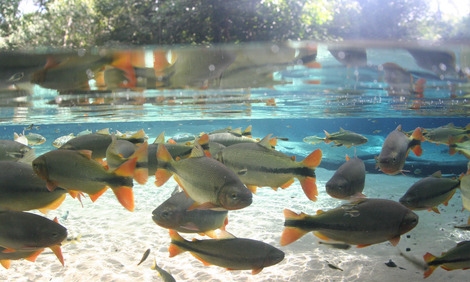Mexico - the most beautiful holes in the ground of our planet
Imagine walking for hours in the dark in narrow corridors 120 m below the earth's surface with only a thin rope to guide you. Since you left the surface three kilometres back you have been going deeper and deeper. Then finally you reach the entrance to a cave that fewer people have entered than have been on the moon. And even fewer have returned alive. The entrance is extremely narrow. You take off all your equipment, push it in front of you, exhale and push your way through the black hole with empty lungs. Then finally you are in the cave of your dreams. And now imagine that all this is taking place UNDER WATER!
This cave, the dream destination of every cave diver in the world, is located in Mexico and belongs to the world’s largest cave system. We aquarists only know the blind cave tetra (Astyanax jordani), which was discovered as early as 1937. For us, the endless caves are more of a nightmare, while the points where they reach the light are our paradise! The Maya used the ground cavities in the porous limestone to fetch water and called them cenotes. The cenotes are scattered across the Yucatan Peninsula and are usually easily accessible. After a short climb or sometimes a comfortable descent by ladder or footbridge you reach the water surface. The water is more than just crystal clear. The aquatic plant stocks often stretch to the surface and look as if an aquascaper had just finished arranging them. Turtles and harmless crocodiles form the backdrop for a snorkelling experience of the very best. The predominant fish group is livebearers, followed by tetras and cichlids. Catfish are present but much rarer. Among the livebearers, the Yucatan mollies are the most impressive, as their size far exceeds that of their aquarium colleagues.
If you have a little time, you should observe the livebearers when they feed. Do they eat the algae or prefer the microfauna that live in the algae? Only a dissection of the stomach contents can tell us! But we'll leave them to eat in peace...
The cenotes all have names, mostly a Mayan name and an English name. The Sac Actun cave system with 226 cenotes forms the longest cave system in the world at 352.9 km. In the main cenote, Sac Actun, water lilies form large populations where many fish can also be found. In the Cenote Actun-Ha, also called Car Wash, a crocodile is the main attraction. But the algae populations are also worth seeing and one wonders why one cenote shows a massive algae problem and the next, only a few hundred metres away, does not have a single algae! The name Car Wash is perhaps no coincidence!
If you would like to see the blind cave tetras, you need to show your diving licence before diving into the cave system with a guide. At a depth of a few metres, which varies from cenote to cenote, you will pass through a halocline, the transition layer between the freshwater at the surface and the heavier seawater below. The halocline is clearly recognisable by the strong streaks in the water, which prevent a clear view. The seawater below is crystal clear again and every diver needs to use his flippers very carefully with the so-called "frog kick" method to avoid sediment being stirred up. Should it happen despite this, visibility will abruptly disappear and when there is no more daylight, you have to feel your way using the guide rope. It’s a head on therapy for claustrophobia! In shallower freshwater areas where tree roots grow through the ceiling into the cave, blind cave tetras can be found with a bit of luck.
Even outside the cenotes it is worth having a short look around. Black iguanas, coatis and snakes can be seen, if there are not too many tourists around.
Travel information:
There are 12 h direct flights from Germany to Cancun in Mexico. There are countless hotels to choose from in Cancun. If you like to see coral reefs, you can make trips to the island of Cozumel, where there are really beautiful Caribbean reefs and in the summer months you can also see whale sharks. Most of the cenotes are located along the coast (Riviera Maya) and can be reached in about 2 h by car. Be sure to visit the picturesque Mayan ruins of Tulum right by the sea, which is on the way to the cenotes. Best in the evening on the way back, when most of the tourists have left. Dive centres in Cancun offer rental equipment and cave dives. Your passport needs to be valid for at least 6 months on entry and there is a €15 fee on exit. There are no vaccination requirements for the region, but vaccination against hepatitis A, tetanus and diphtheria is always recommended. The area is malaria-free but a good mosquito repellent is useful as dengue fever cases have occurred. Don’t forget to reapply mosquito repellent when you leave the water as the water will have washed it off!
If you fly to Mexico and haven't seen the cenotes, you're missing out on one of the most exciting destinations for aquarium enthusiasts!
Complete information on the JBL Expedition Central America with all the measurement data can be found here: Expedição América Central & Galápagos .
